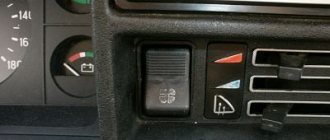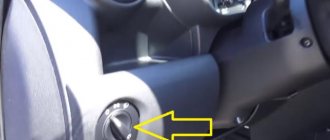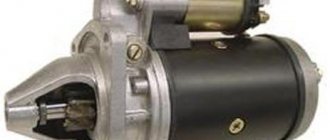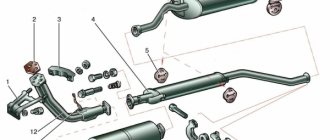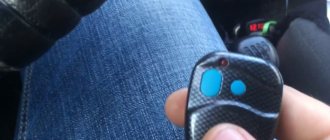The car has many devices and units that provide a comfortable ride. They are so familiar that when they work properly, they are simply not noticed . However, their failure often leads to serious problems. All this fully applies to the windshield washer or, as it is often called, “washer”. When the washer does not work, visibility and, as a result, traffic safety are sharply reduced. It’s especially unpleasant when this happens after rain or in slush - dirt quickly sticks to the windshield, which the wipers cannot cope with...
Design of the washer on the “nine”
The diagnostic procedure is perceived as more accessible if you are familiar with the design of the module. And here it is, almost like on the Lada Vesta - it consists of simple elements:
- tank;
- 2 motors (rear and front);
- pipelines;
- 3 injectors (two on the front of the hood, one on the rear);
- wiring.
This concept has become widespread on new hatchbacks. Carburetor versions have a different layout. One motor and two electromagnetic valves (EMVs) are installed there, distributing, respectively, to two channels.
Block under the hood
It is located next to the washer fluid reservoir, under the protective cover.
Description
Option 1
| F1 | 10A Emission control system |
| F2 | 15A Emission control system |
| F3 | 15A Emission control system |
| F4 | 10A Emission control system |
| F5 | 30A Diesel combustion products filter evaporator, Glow plug control system |
| F6 | 3A Anti-lock braking system. Maintaining sustainability. Ignition |
| F7 | 7.5A Powertrain control module |
| F8 | 20A Cooling Fan |
| F9 | 30A Left windshield wiper |
| F10 | 30A Right windshield wiper |
| F11 | 10A Air conditioning compressor clutch |
| F12 | 20A Glow plug for the evaporator of the diesel combustion product filter |
| F13 | Reserve |
| F14 | 30A Emission control system - ignition |
| F15 | Not used |
| F16 | Not used |
| F17 | Not used |
| F18 | 40A Anti-lock brakes, stability control pump |
| F19 | 30A Starter Solenoid |
| F20 | 60A Glow plugs |
| F21 | 60A Ignition relay 3 |
| F22 | Reserve |
| F22 | Reserve |
| F23 | Reserve |
| F24 | 7.5A High Pressure Fuel Pump |
| F25 | Reserve |
| F26 | Reserve |
| F27 | Reserve |
| F28 | Reserve |
| F29 | Reserve |
| F30 | 40A Cooling fan 1 |
| F31 | 40A Fan 2 cooling systems |
| F32 | 60A Electric motors (two) windshield wipers |
| F33 | 20A Start-stop auxiliary water pump |
| F34 | Reserve |
| F35 | 15A Power supply for powertrain control system |
| F36 | 15A NOXI 2 sensor |
| F37 | 7.5A Volume control valve |
| F38 | 7.5A Mass air flow sensor |
| F39 | 15A Diesel Pump Fuel Evaporator |
| Relay | |
| R1 | Ignition |
| R2 | Starter |
| R3 | Rear window wiper |
| R4 | Not used |
| R5 | cooling Fan |
| R6 | Windshield wiper - on and off |
| R7 | Windshield wiper - low and high speed |
| R8 | Not used |
| R9 | Not used |
| R10 | Air conditioning compressor clutch |
| R11 | Evaporator system fuel glow plug |
| R12 | High pressure fuel pump |
| R13 | All Wheel Drive Pump |
| R14 | Econetic system |
| R15 | Cooling fans: high speed and low speed |
| R16 | Emission control system |
| R17 | Powertrain Control Module |
| R18 | Cooling fan - high speed |
Option 2
| F1 | 5A Switching off the radio sound |
| F2 | Reserve |
| F3 | Reserve |
| F4 | Reserve |
| F5 | Reserve |
| F6 | 15A Nitrogen oxide sensor |
| F7 | 15A Particulate Sensor |
| F8 | 20A High Speed Cooling Fan |
| F9 | Reserve |
| F10 | Reserve |
| F11 | Reserve |
| F12 | Reserve |
| F13 | Reserve |
| F14 | Reserve |
| F15 | Reserve |
| F16 | Reserve |
| F17 | Reserve |
| F18 | 40A Cooling Fan 2 |
| F19 | 40/60A cooling fan |
| F20 | 40A Emission control system |
| F21 | 40A Glow plug 2 |
| F22 | 40A Glow plug 1 |
| F23 | 10A Air conditioning compressor clutch |
| F24 | Reserve |
| F25 | 15A Right headlights with high intensity discharge lamps |
| F26 | 15A Left headlights with high intensity discharge lamps |
| F27 | Reserve |
| F28 | 5A Heating element for positive crankcase ventilation valve |
| F29 | 7.5/15A Coolant pump |
| F30 | 40/60A Powertrain Control Module Relay |
| F31 | 20A Run-start relay 2 |
| F32 | 20A Fuel fired auxiliary heater |
| F33 | Reserve |
| F34 | Reserve |
| F35 | 20A Powertrain Control Module |
| F36 | 20A Power wire 5 car |
| F37 | 15A Tank with reagent. Exhaust gas recirculation valve |
| F38 | 10A High speed cooling fan. Air conditioning compressor clutch. Low speed cooling fan. High and low speed cooling fan relay. Relay coils R1, R5, R10, and R15 of the engine electrical junction box |
| F39 | Glow plug control system |
| Relay | |
| R1 | High speed cooling fan |
| R2 | Not used |
| R3 | Rear window wiper |
| R4 | Air suspension module |
| R5 | Cooling Fan |
| R6 | Not used |
| R7 | Left headlights with high intensity discharge lamps |
| R8 | Right headlights with high intensity discharge lamps |
| R9 | Starter |
| R10 | Air conditioning compressor clutch |
| R11 | Not used |
| R12 | Not used |
| R13 | Emission control system catalyst |
| R14 | Not used |
| R15 | Low speed cooling fan |
| R16 | Not used |
| R17 | Not used |
| R18 | Powertrain Control Module |
Why the rear and windshield washer does not work on the VAZ 2109: possible reasons
A trivial reason for claiming a malfunction may be the lack of washer fluid in the tank. At the same time, the motor hums, and the emulsion is not supplied from the sprayers. You can't call it a breakdown. There is water in the container, but it does not splash. This set of circumstances is less pleasant - perhaps one of the electrical components has failed. There's no point in getting lost. It's better to look for slot F7 in the fuse block. The two-contact plate inserted into it must be intact. If damaged, then the part must be replaced.
It is quite possible that the problem is not the fuse at all. The machines of the ninth family are far from new, so there may be problems with any of the electrical network nodes:
- motor;
- solenoid valves;
- Understeering's shifter;
- wiring.
If the standard windshield washer does not work on a VAZ 2109, and water splashes from the nozzle at the rear, then most likely the front solenoid valve is closed. The essence of the diagnosis: we swap the functional purpose of the valve devices. To do this, switch the power terminals from the rear EMC to the front. If the problem really is a faulty damper, then now the liquid will spray onto the front glass, and there will be silence from behind. The solution is obvious - change. The steering column switch, although a durable unit, is not immune to damage. You can check the unit in one invoice. By pressing “towards yourself,” the plus is applied to the motor and valve. Then it’s a matter of technique - the assistant holds the lever, and the performer under the hood uses a multimeter to measure the voltage between the positive wire and ground: it should be 12 Volts.
If the device shows 0 V, there is no need to rush to dispose of the steering column paddle. You should evaluate the performance of the wire going from the switch to the motor and valves. We connect the ends with a tester and look at the resistance. A zero value in Ohms indicates wiring integrity.
Electrical appliances may work properly, but water will not spray out. This is a reason to inspect the injectors - perhaps they are clogged.
System diagnostics
A working washer blows a jet of water onto the windshield glass, while at the same time the blade moves. You can determine which element needs replacement as follows:
- We start the engine and open the hood.
- We ask an assistant to pull the steering column switch lever towards you.
- If the pump is running, it will be clearly audible.
- There is no water jet blowing - this means that the nozzles are clogged.
If the liquid in the tank is frozen and needs to be replaced, then such a malfunction is difficult to miss.
We treat and improve
Surely all owners know that even a fully functional system produces little pressure. The reason for this is the low power of the standard motor. If the windshield washer does not work on a VAZ 2109, you can eliminate the cause and at the same time tune the system by installing a pump from:
To be completely sure, you can install:
- fan injectors (for example, from Volvo S80);
- a check valve that prevents fluid from draining from the rear injector line;
- filter to prevent clogging of nozzles.
Mechanical breakdowns
The most common reasons why the VAZ 2114 windshield washer does not work are mechanical damage.
The most common of them are:
- the washer fluid has run out in the tank;
- the pipeline leading to the windshield wiper is clogged;
- the windshield wiper nozzles are clogged;
- the water used as washer fluid froze;
- the hose fell off the pump;
- the hose going to the windshield wiper is pinched;
- The supply hose has ruptured.
Problems related to washer fluid can be solved almost instantly - if it runs out, it should be topped up; if it is frozen, take the expansion tank to a warm room, warm it up, then drain the water or liquid that is inappropriate for the season and fill it with non-freezing one.
How is it arranged?
The washer system consists of:
- tank (located on the right in the photo);
- pump (motor);
- water supply hoses;
- nozzles that directly supply water to the windshield of the car.
Injector kit
The nozzles are installed so that the jet is directed towards the middle part of the glass. A pump (motor) is necessary for direct water supply. It should be noted that in some modifications, water is supplied simultaneously to the headlights and also to the rear window.
Pump motor
The pump itself is a small motor consisting of:
This part is significantly different for different modifications. But there is only one purpose - to supply washer fluid. In most cases, the malfunction lies either in the tank itself or in the injectors. Depending on the modification of the car, these elements need to be replaced or simply repaired. But if the motor breaks down, it will most likely need to be replaced.
Operating principle of the device
So, an electric pump is currently being installed; previously it was a mechanical one. We also have a tank in which the glass spray liquid is stored. Naturally, there are two tubes through which it flows to two sprayers. The volume of the tank can be 2.5-5 liters, which is quite enough for a long period of operation, due to the efficiency of the injectors. The electric pump located in the reservoir is activated by the steering column switch. This way, cleaning liquid is supplied to the windshield and the wipers turn on for a while.
Ordinary water is used as a working fluid - this applies to the summer period, but in winter, when it is cold, a special “anti-freeze” is added there. Two types of nozzles are used: jet and fan. It’s difficult to say which is better, both of them give excellent results. That’s probably all that concerns the device and operating principle of the washer.
Where is?
Everyone knows the situation when the water in the windshield washer reservoir runs out, but in order to top it up, you need to at least have an idea where it is. And this is a problem for some, because when we open the hood, we see several tanks at once, and it’s hard to figure out where exactly the one we need is located.
The tank we need is usually located to the right of the battery, and next to it is the block that contains the fuse that is responsible for the windshield washer system.
Prevention measures
In order to avoid sudden problems with the operation of the windshield washer system, you must:
- promptly refill the washer reservoir with antifreeze liquid and remove water from the system;
- check the quality of the antifreeze in the freezer; it is better to buy liquid at a gas station;
- remove the chip from the pump and inject silicone grease into the contact area, it pushes water out of the contact area, preventing corrosion;
- if the tubes crack, replace them with serviceable ones, you can take silicone tubes from an IV (sold at any pharmacy);
- When operating a vehicle at temperatures below minus 25 degrees Celsius, it is recommended to install heated injectors.
How to repair?
The glass washer system is not complicated, and the faults are almost the same in most cases, so once you become familiar with them, you can carry out the repairs yourself.
Mechanical reasons
| Elimination method | |
| The fluid in the washer reservoir is frozen | It is necessary to drive the car into a room where the temperature is above zero, close the hood, start and warm up the engine thoroughly. Fill with new antifreeze fluid. |
| The hose came off | Put the hose back in place. |
| The motor shaft turned. You can hear the washer motor making noise, but no fluid comes out. | Replace the mechanism. |
| The hose through which water flows to the nozzles is pinched | Replace or straighten the hose. |
| The injectors are clogged | Clean or replace. |
Electrical problems
| Elimination method | |
| Fuse burned out | You need to open the fuse box, and then, using a reference book or the table on the cover, find out which fuse is responsible for the windshield washer, remove and check it. If it turns out that it is burnt out, replace it with a similar new one. |
| Oxidation or decomposition of the terminals connected to the motor | You need to clean the terminals, check the connections and install it in place. It is better to clean with a soap solution using a toothbrush. |
| The washer switch is faulty | Replace or repair it. |
Ways to solve problems with washer fluid freezing
Drivers regularly face the problem of liquid freezing during the winter season. Even the most resistant substances may not retain their properties in severe frosts. As a result, some drivers turn off the system until the weather warms up, while others use alternative solutions to the problem. What to do if the windshield washer freezes:
- Move the car to a warm, heated garage or parking lot until the fluid restores its previous properties. This option is suitable only for those who have free time and access to insulated premises.
- Temporarily remove the water tank, if possible, and warm it indoors. After defrosting, the tank must be installed back.
- Fill the reservoir with anti-icing washer fluid, which is designed to work in extreme conditions, including the range from -70 to -50 degrees.
In winter, it is not recommended to completely fill the washer reservoir. Due to the expansion of frozen liquid, the reservoir may crack or burst.
Video “Improving front window washing”
This video tells you not only where the windshield washer system is located, but also how to make it work better.
The windshield and rear window of the car must be kept clean; any contamination reduces visibility of the road and what is happening around, which can lead to an emergency. The windshield washer is designed specifically to keep it clean; the importance of such a device can be put on a par with the engine or chassis, therefore, as soon as deviations in its operation appear, the cause of the breakdown should be immediately determined and eliminated.
conclusions
If the rear or windshield washer fails, any problem can be quickly resolved, the main thing is to find the cause of the malfunction. In case of problems with nozzles and their complete replacement, it is better to choose these fan-type parts; they wet the glass better. Problems with the integrity or partial deformation of connecting tubes are best solved by connecting new cords. To avoid the listed problems with the washer system, you should use non-chlorinated water in warm weather, and “anti-freeze” water in cold weather.
Causes of washer malfunction
If the windshield washer does not work, it will not be difficult for an experienced driver to identify the cause of such a malfunction, and even a beginner, after familiarizing himself with the main failures in the cleaning system, will be able to eliminate them on his own.
Mechanical problems
The most important reason, as mentioned above, may be the lack of washer fluid; in this case, you just need to top it up. If it is present, but does not splash in the winter, then perhaps it is simply frozen. In this case, the problem can be solved in one of two ways:
- warming up the engine;
- bringing the car into a warm garage.
After the liquid has thawed, the system will begin to operate as usual, but it is better to drain the water from the tank after this and replace it with an “anti-freeze” one.
Other significant mechanical reasons why the windshield washer does not spray include the following factors.
- Clogged injectors . Their exit can be blocked by various debris: rust, dirt or small particles. To check the correctness of the guess, you need to stop the supply of working fluid to the nozzles; if this is the case, then the supply of “anti-freeze” will be normal. The solution to this problem lies in replacing the nozzles.
- Disconnecting the hose . It may simply fly off while driving on bumpy roads, and then the fluid supply will continue, but the headlight and windshield washer nozzle will remain dry. Sometimes this happens in cars in which the connecting fittings are located on the hood, then when it is closed, the hoses are squeezed. In any case, the deformed or torn tube must be replaced and returned to its place.
Replacement
If the old motor has failed, there is no point in trying to repair it somehow. To buy a new part, you will have to spend very little money. And the replacement procedure on most cars is extremely simple.
I will describe the main stages of work associated with replacing this element of the windshield cleaning system of any car.
- Turning off the vehicle's power. A safety measure without which further work makes no sense. Be sure to remove the negative terminal from the car. It's simple but important. Otherwise, you not only risk burning the wiring, but also getting an unpleasant electric shock yourself.
- Search for a motor. It all starts with identifying where your windshield wiper motor is located. It depends on your car. On some cars, just lift the hood and you will immediately see the washer reservoir. The motor itself is located on the reservoir (partially inside) of the windshield wiper, into which the liquid is poured. Do you see the tank? If yes, then you are in luck. If not, then you will have to look for it by removing elements of the engine compartment. On some car models, the tank is hidden so that the fender protection has to be removed.
- Disconnect the connectors with wires from the motor. Then remove the tank itself.
- The hose and fitting are separated from each other. Don't forget to drain the liquid. Filling a new one will not be difficult. Yes, and for prevention it won’t hurt to do it.
- Using a screwdriver, push the intake seal out of the bushing. This will allow you to completely remove the windshield washer motor.
- Don't forget to install a new bushing when reassembling. This often leads to the washer pump itself breaking down. So the old bushing goes to the landfill.
- Reassemble the assembly in reverse order. Here many craftsmen relax, because they consider the work done. In fact, reassembly causes more problems than disassembly. Advice from someone who made similar mistakes. That is, from me. Do not try to remember the location of parts unless you are confident in your memory capabilities. We got distracted by something, forgot, got confused. This happens to everyone, and there is nothing wrong with it. To ensure proper reassembly sequence, you can record, mark, or label the parts in the order in which they are removed. This will make it easier to put everything back together the way it was before.
The instructions are for informational purposes only, as the procedure may differ depending on the car model. Consult your machine's owner's manual for assistance. This is the best visual aid for self-repair.
There is nothing complicated in this work. Even the car owner who prefers to solve most problems with the help of a car service can easily cope with it. Repairs cost several hundred rubles and take a maximum of a few hours.
Do-it-yourself troubleshooting
The main reasons for the lack of washer fluid can be eliminated with your own hands.
Cleaning the injectors
Their replacement and cleaning occurs in the same way and it begins with the removal of these parts, the process is as follows:
- open the hood;
- make sure that they have plastic plugs; if they are present, they must be carefully removed;
- take a flat-head screwdriver and open their spring fasteners to remove the injectors.
Installation of new parts occurs in the reverse order.
To wash the injectors and free them from dirt, you should prepare a special cleaning solution of non-chlorinated water and vinegar, taken in equal proportions. The mixture is mixed well and then poured into the tank. After which you need to press the washer lever, even if the water does not reach the glass, it’s okay. So that the components of the solution have time to break down all the contaminants, you need to leave it in the cleaning system for 2 hours, and then press the lever again. After the dirty solution flows out of the nozzles, rinse the hoses with distilled water.
Replacing the motor
It is quite difficult to repair the motor yourself, so most often it is simply replaced.
Installation of a new device is carried out as follows:
- remove all liquid remaining in the tank from the tank;
- disconnect the contact between the battery and the pump;
- if necessary, you can dismantle the tank, but if manipulations can be carried out with a fixed device, then you don’t have to do this;
- remove the electric pump from the tank and unscrew all the hoses going to it, but just remember their location so that after repair they can all be returned to the correct places;
- connect a new pump to the system;
- screw all the tubes;
- connect the battery to the motor;
- pour liquid into the reservoir.
Check the operation of the motor by pressing the washer lever; if you hear a whirring sound from the pump, then everything went well.
Additional Information
How to change the cigarette lighter fuse
Here is an example of how to correctly change the cigarette lighter fuse on a BMW X3 E53.
Russian translation of errors from the dashboard
RELEASE PARKINGBRAKE-Release the parking brake CHECK BRAKE FLUID-Check the brake fluid level STOP! ENGINE OILPRESS-Stop! Low engine oil pressure COOLANT TEMPERATURE-Coolant temperature* BOOTLID OPEN-Trunk open DOOR OPEN-Door open CHECK BRAKE LIGHTS-Check brake lights CHECK LOWBEAM LIGHTS-Check low beams CHECK TAIL LIGHTS-Check tail lights CHECK PARK LIGHTS-Check side light CHECK FRONT FOGLAMP-Check front light. fog lights CHEK REAR FOGLAMP CHECK NUMPLATE LIGHT CHECK TRAILER LIGHTS CHECK HIGHBEAM LIGHT CHECK REVERSE LIGHTS CHECK REVERSE LIGHTS TRANS. FAILSAFE PROG-Automatic transmission emergency program CHECK BRAKE LININGS-Check the brake pads WASHER FLUID LOW-Add water to the washer reservoir CHECK ENGINE OIL LEV-Check the engine oil level IGNITION KEY BATTERY-Replace the ignition key battery CHECK COOLANT LEVEL-Check the coolant level LIGHTS ON ?-Is the light on? CHECK STEERING FLUID LEV - Check the hydraulic steering oil
Electrical
Problems with electrical systems are rare. You can fix them yourself, but if in doubt, contact an experienced mechanic.
- The first place among the problems is the failure of the fuse. It’s easy to fix the problem - re-read the car’s operating instructions and use the symbols to find the required fuse and replace it with a new one.
- Another reason is that the washer motor does not work. The reason is oxidation of the terminals or their falling off. To eliminate the malfunction, you need to clean the contacts and reconnect the components if necessary.
- It also happens that the washer switch on the steering wheel does not work. You can check this using a multimeter. Connect the device to the motor terminals and check the voltage. If it is in order, but the mechanism does not work, most likely the switch is to blame. But a problem in the electrical wiring or lack of closure of the device relay cannot be ruled out. If it doesn’t work after replacing it yourself, you can’t do it without an experienced technician.
